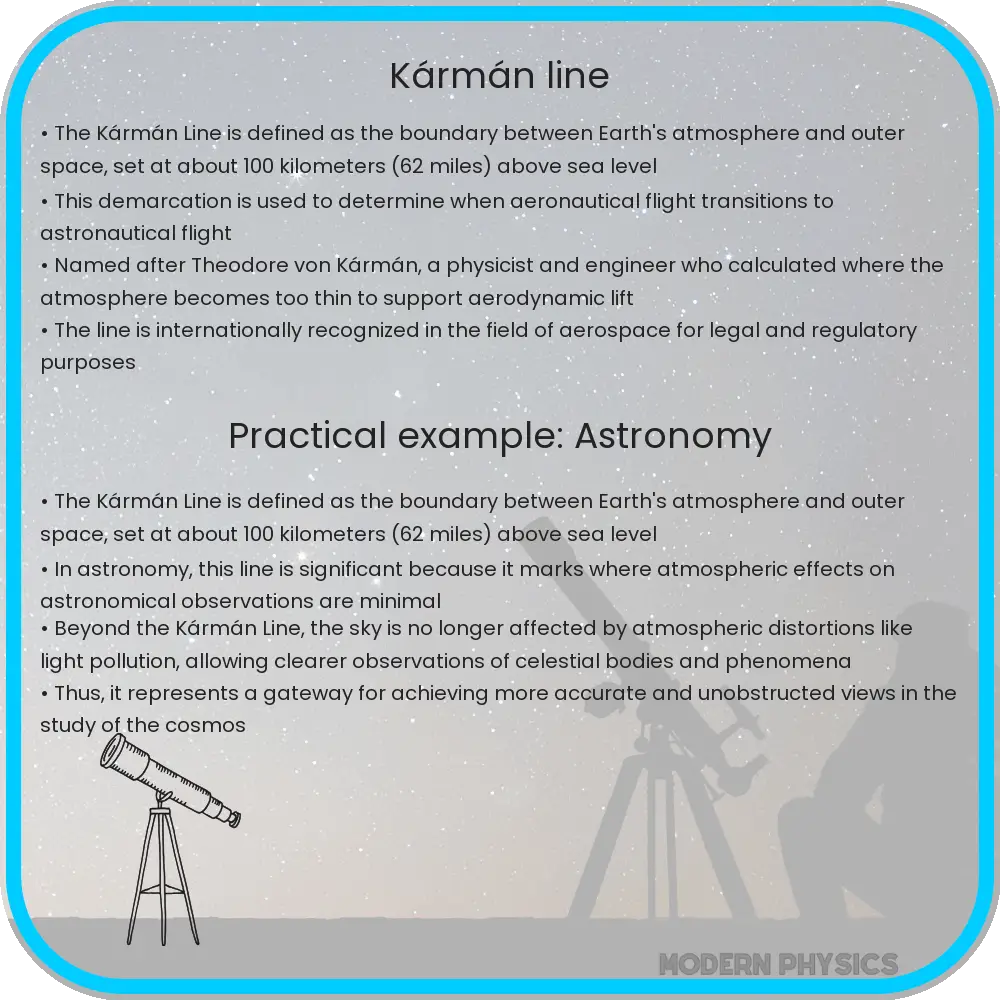The Kármán line marks the boundary between Earth’s atmosphere and space at 100 kilometers altitude, critical for aerospace laws and physics.

Understanding the Kármán Line: The Gateway to Space
The Kármán line is often referred to as the boundary between Earth’s atmosphere and outer space. Set at an altitude of about 100 kilometers (62 miles) above sea level, this line is crucial for several reasons, from regulatory and legal perspectives in aerospace activities to technical challenges in atmospheric physics and engineering.
Why 100 Kilometers?
The choice of 100 kilometers as the boundary is not arbitrary. It originates from the work of Hungarian-American engineer and physicist Theodore von Kármán, who was instrumental in understanding the behavior of aircraft and spacecraft. The line represents the altitude where the atmosphere becomes too thin to support aeronautical flight using wings, because the air is too thin to generate significant lift. At this altitude, an aircraft would need to travel faster than orbital velocity to derive sufficient aerodynamic lift, which effectively means it would be in space, orbiting Earth.
Significance of the Kármán Line
The designation of the Kármán line has significant practical implications. It serves a critical function in space law and policy, determining where airspace ends and outer space begins. This demarcation is important for managing and regulating activities like satellite launches, space travel, and the passage of international spacecraft.
- Legal and Regulatory Frameworks: The Kármán line helps in crafting regulations that both enable space exploration and protect national and international security interests in the near-space environment.
- Space Records and Achievements: It provides a clear benchmark for setting and recognizing records in aeronautics and astronautics, such as the altitude records for balloons, airplanes, and human spaceflight.
Hydrodynamics Impact at the Kármán Line
The behavior of fluids (which includes air in the context of aerodynamics) changes dramatically as one approaches the Kármán line. The thinning atmosphere affects the hydrodynamic (and by extension, aerodynamic) properties crucial for flight. At lower altitudes, aircraft rely on the lift generated by their wings, which is a result of the behavior of air molecules flowing over and under them. However, as altitude increases and the air thins, this lift generation becomes inefficient.
Hydrodynamic and aerodynamic equations that describe lift and drag must therefore adapt to lower pressure and density. Reynolds number, a dimensionless quantity in fluid mechanics used to help predict flow patterns in different fluid flow situations, decreases significantly as one approaches the Kármán line. This challenges engineers to rethink conventional aircraft design and to innovate with technologies geared towards achieving and surviving spaceflight.
The transition from thicker atmospheric layers to the near vacuum of space also highlights the pivotal region where traditional aircraft engines, which require oxygen, give way to rocket propulsion, which carries its own oxidizer. This shift is crucial in the design and operation of hybrid vehicles like spaceplanes, which must operate efficiently across a vast range of atmospheric conditions.
Understanding and addressing the challenges posed by the transition through the Kármán line involve sophisticated models that incorporate thermodynamic, mechanical, and chemical changes encountered by vehicles transitioning from atmospheric flight to space travel.
Technological Challenges and Innovations at the Kármán Line
As vehicles pass through the Kármán line, they encounter unique technological challenges that require innovative solutions. One of the primary issues is the transition from aerodynamic flight to rocket propulsion. Engineers must design vehicles that can operate in both the dense atmosphere of Earth and the vacuum of space. This dual-environment capability necessitates robust, versatile materials and engineering practices that consider thermal extremes, radiation exposure, and mechanical stresses.
- Material Science: Advances in material science play a crucial role in developing components that withstand the extreme conditions of both Earth’s atmosphere and space. Materials need to have high tolerance to temperature fluctuations and resistance to radiation.
- Propulsion Systems: Hybrid propulsion systems that can switch between jet propulsion for atmospheric flight and rocket engines for space travel are critical for the next generation of spaceplanes.
Educational and Commercial Implications
The Kármán line not only has scientific and technological significance but also holds educational and commercial value. It serves as an educational demarcation that helps in teaching astrodynamics and aerospace engineering by providing a clear boundary where different physical principles come into play.
Commercially, the Kármán line opens avenues for space tourism and other business ventures in near-space environments. Companies pioneering space travel, like SpaceX and Blue Origin, use this boundary to define their missions and market their achievements, thereby fueling interest and investment in space technologies.
Conclusion
The Kármán line, at approximately 100 kilometers above Earth, signifies more than just a physical boundary; it represents a gateway to the final frontier. The complexities encountered near this line push the boundaries of current aerospace technology and invite continuous innovation in materials, propulsion systems, and operational strategies. This demarcation serves as a critical reference point for legal, educational, and commercial ventures, ultimately shaping the future of human activity in space.
By understanding the importance and implications of the Kármán line, we can appreciate the incredible ingenuity and effort that goes into overcoming the challenges of transitioning from atmospheric flight to space exploration. It propels not only scientific advancement but also stirs the global imagination, inspiring the next generation of engineers and scientists to reach beyond the visible horizon and into the mysteries of space.
